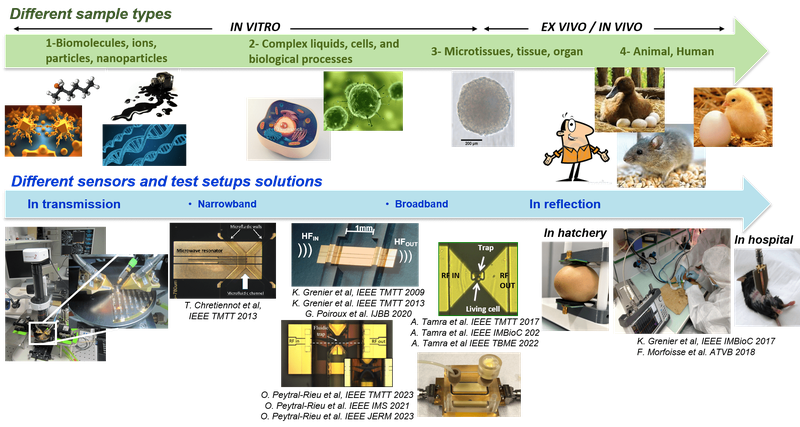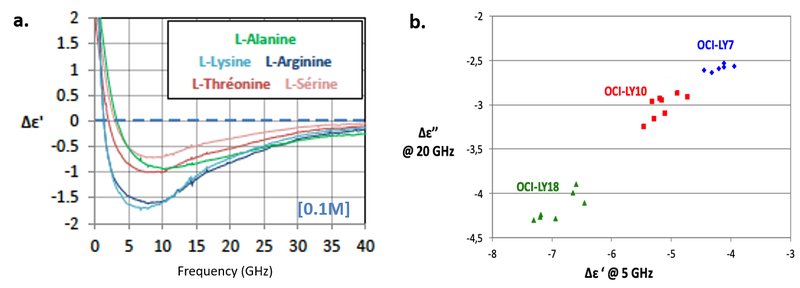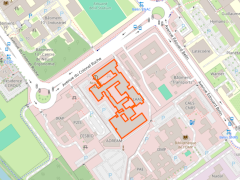Dielectric characterization of materials - non-invasive analysis
Non-destructive, non-invasive analysis of complex fluids, including homogeneous, heterogeneous, inert, living, static or moving media, through the development of microwave dielectric spectroscopy techniques
Context
Over the last fifteen years, we've been working to better understand the two fundamentals of the interaction between electromagnetic waves and biological matter at microwave and millimeter frequencies. In addition to penetrating biological matter, giving access to intracellular dielectric activity, these waves are also highly sensitive to water molecules, an essential constituent of living matter. Any change in the structure of the molecular network of water, including the proportion of free and bound water and occurring, for example, when molecules or particles are added or modified, results in a change in the microwave dielectric response of the medium. At microwave frequencies, the dielectric response is therefore dominated by that of water molecules, which thus constitute a natural marker. The aim of our work is to understand, highlight and exploit the detection and analysis capabilities of the microwave dielectric spectroscopy technique at different scales, from molecules, micro-organisms, cells to organs, whether in vitro or in vivo, at various levels of spatial and temporal resolution, and for a variety of application fields (biology, medicine, agriculture, chemistry).

Figure 1: Systems and models studied using the microwave dielectric spectroscopy technique, classified according to the sample studied, the measurement method and the spatial resolution.
We are particularly interested in the analysis in culture media of the response of biological cells to various stimuli (i) chemical, such as therapeutic agents [1], (ii) electrical for electroporation of the membrane and facilitating the entry of molecules [2], or (iii) thermal, both static and dynamic [3].
In parallel with these in vitro studies, in vivo work is being explored in new fields of application, such as the quantification and identification of molds present in space vessels, or precision agriculture for early egg sexing and organ monitoring (as in the case of skin melanoma detection, or for evaluating the efficacy of lymphedema treatments in mice [4]).
To this end, we are developing an arsenal of sensors and detection devices tailored to the specificity of the samples to be analyzed.
In the biological and biomedical fields, we are looking at the prospects of early diagnosis and personalized therapies, thanks to upstream evaluation of the efficacy of therapeutic agents on the patient's own cells. In the agricultural sector, our studies focus on animal welfare.
Example of results: specificity of response of microwave dielectric spectroscopy technique
For biological and medical applications, it is crucial to establish the specificity of the response of the microwave dielectric spectroscopy technique. We have demonstrated that the discrimination of different biomolecules such as amino acids in aqueous solution and of cells from B lymphoma subpopulations is possible (Figure 2) [5, 6]. For the latter, only destructive, costly and time-consuming cytogenetic analyses allow such selectivity.

Figure 2: a) Dielectric responses of different amino acids. b) Dielectric responses of different B lymphoma cell lines showing their possible discrimination.
References
- [1] K. Grenier et al., IEEE IMBioC 2018 ; A. Zedek et al., IEEE IMS 2017 ; A. Tamra et al., IEEE IMBioC 2019
- [2] A. Tamra et al., IEEE T-MTT 65 (9), 3512-3518 (2017) ; A. Tamra et al. IEEE J-ERM, 3 (2) (2019)
- [3] A. Zedek et al., IEEE IMS 2017, Jun 2017, Honolulu, United States. (2017)
- [4] D. Dubuc et al., IEEE IMBioC 2017 ; F. Morfoisse et al., ATVB, 38 (5), (2018)
- [5] F. Artis et al., IEEE IMBIoC 2018
- [6] K. Grenier et al., IEEE IMS 2018












